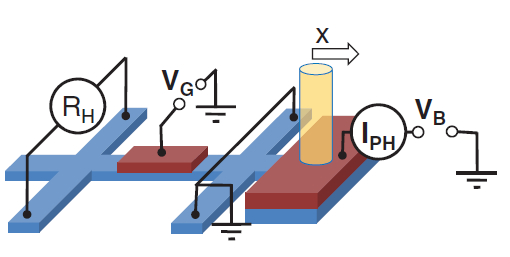Last week I blogged about the potential of using the magnetic properties of an electron, its spin, for novel electronics. And already this week we have come a step further towards spin electronics through the demonstration of a spin-based transistor device!
In spin electronics, it is the spin of the electron and not its electrical charge that could be used for computing. Indeed, this could be done entirely without electrical currents, and would be more energy efficient as it is easier to switch a spin than carry an electric current. In such devices, the spin can assume two orientations, which can be used to represent the 1 and 0 of computer bits.
The fundamental unit of a computer is the transistor. So what about the equivalent for spin electronics, the spin transistor? Well, the concept of a transistor that only switches an electron’s spin instead of charge was proposed 20 years ago by Supriyo Datta and Biswajit Das, but was never realized. The problem has been to control the spin of an electron in a clear and efficient way by electrical voltages while it is in transit through a nanoscale device.

The Spin Hall effect transistor. (c) Science 330, 1801 (2010)
Work by Jörg Wunderlich from the Hitachi Laboratory in Cambridge, Tomas Jungwirth from the Institute of Physics in Prague and the University of Nottingham in the UK, and their colleagues now published in Science comes the closest yet to the Datta-Das spin transistor: they present a spin Hall effect transistor.
Unlike the Datta-Das transistor, which basically is the concept of the conventional transistor transferred to spin electronics, the spin Hall effect transistor is a little more elaborate. The researchers excite electrons with a predefined spin (yellow cylinder in the figure). As the electrons travel from there to the other end of the device they scatter and get diverted either to the left or the right, depending on the direction their spin is pointing at. If the electrons all have spins pointing in the same direction, as in the experiment, they all get deflected in the same direction. This creates a Hall voltage along a crossbar (RH in the figure), even though no electric current flows in this device.
Another crossbar close to the point where the electrons with uniform spin are excited ensures no electrical currents can flow, because this crossbar is electrically grounded and therefore sets any voltages to zero. The spin orientation, however survives. Otherwise there would be no Hall voltage in the experiments.
So far, there is nothing too surprising, the spin Hall effect is known. What is new in this structure is that a transistor element is added: the gate. In a conventional transistor the gate voltage (VG) controls the flow of electrons and turns the transistor on and off, which means it can switch the bits from 1 to 0. The researchers now apply a similar voltage to their structure. And even though no electric current flows, this voltage turns the transport of spin, and hence the Hall voltage, on and off.
Even though this structure is a good deal more complicated than a conventional transistor, it demonstrates the principle that a pure spin current can be controlled in a similar way to a conventional transistor. Of course, we are still far away from applications. For example, the spin signal is created optically and not electronically. But what it accomplishes beautifully is to show how close we have come to realize a spin transistor. Twenty years after the paper of Datta and Das it is about time!
References:
Datta, S., & Das, B. (1990). Electronic analog of the electro-optic modulator Applied Physics Letters, 56 (7) DOI: 10.1063/1.102730
Wunderlich, J., Park, B., Irvine, A., Zarbo, L., Rozkotova, E., Nemec, P., Novak, V., Sinova, J., & Jungwirth, T. (2010). Spin Hall Effect Transistor Science, 330 (6012), 1801-1804 DOI: 10.1126/science.1195816


December 31, 2010 at 22:46
A very insightfull article!